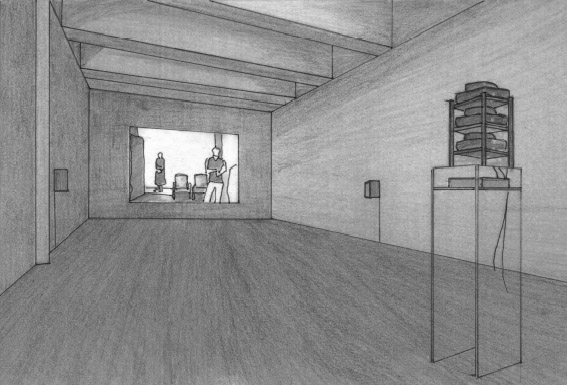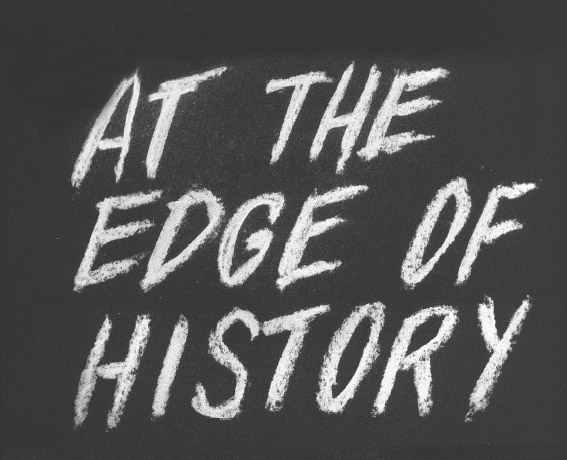TECHARCHAEOLOGY: WORKS BY JAMES COLEMAN AND VITO ACCONCITIMOTHY VITALE
2 DISCUSSION2.1 GENERALPornography in the Classroom was in a smaller room than INITIALS, with an uncarpeted floor that made the sound much more active. It was also a more complicated experience to comprehend, and it could be argued that it was markedly less subtle.
The two works were a study in contrasts, on several levels: size, period of creation, degree of documentation, nature (conceptual vs. formalist), artist involvement in the work's preservation, need to preserve in original state, and need for the artist's presence during installation. Acconci's Pornography in the Classroom was originally conceived in 1975 as a conceptual work. The Pamela and Richard Kramlich Collection of Media Art in San Francisco acquired the work from the Barbara Gladstone Gallery in 1998. The work has three visual elements.1 The two video channels (monitor and projection) were remastered to DVD for the Kramlich Collection's Seeing Time exhibition by SFMOMA, with the artist's permission. The monitor channel has a synchronized audio element.2 The third visual element is a continuously cycled group of 80 color slides. It has been suggested that the work was remastered or remade recently into its current Betacam SP video format (see the discussion below). The Coleman piece, INITIALS, was more recently conceived, in 1993–94. The Kramlich Collection acquired the work from the Marian Goodman Gallery in 1995. While Coleman does not wish to be categorized, he is seen by most curators as 2.2 OVERVIEW OF PORNOGRAPHY IN THE CLASSROOMThere is only one edition of Vito Acconci's Pornography in the Classroom.3 The Kramlich Collection's accession documents from the Barbara Gladstone Gallery state that the artist holds the slide and video masters. The 25-year-old work was acquired in its artist-approved reformatted and (possibly) remastered or remade form. The installation instructions are not comprehensive. Acconci did not participate in the installation. He was not present for the TechArchaeology Symposium. The projection video channel was Super-8mm film in 1975, however, the video image shows no signs of frame jitter due to worn sprockets, no scratches in the original film, splices, lost frames from breaks, color fading from age, or nonuniform processing. If the original film had been remastered, one or more of these markers would be present. There is no mention of the original Super-8 film “masters” in the Barbara Gladstone Gallery documentation. Acconci (2001) remembered that the monitor channel was originally video; we assume it was 1/2 in. open reel video. The Seeing Time catalog entry (Riley et al. 1999) states:“Media: eighty 35mm slide transparencies, two BetaSP video tapes authored to DVD (digital versatile disc) (original Super-8 film remastered to BetaSP video). ” BetaSP is assumed to be Betacam SP (standard play). Pornography in the Classroom was either reformatted from its original 1975 form to a new exhibition form in 1998, or it was reshot onto video in 1998 from 1975 materials, such as 1975 pornography magazines. The monitor channel was originally video, but it is not clear if it was remastered or remade in 1998. The 1998 materials were further reformatted in 2000, from Betacam SP to DVD, for the Seeing Time exhibition. In the absence of complete documentation and full discussions with the artist, it is assumed that Super-8 film, 1/2 in. open reel video, and slides were the original formats (see below). In the SFMOMA Seeing Time installation, the slide element was projected across the room from a slide projector on top of the monitor (figs. 3, 4, 5, 6). The monitor and projected video channels (see figs. 1 and 7) were in opposite corners diagonally, 25–30 ft. apart, perpendicular to the room entrance. A drawing of the image and component placement (appendix A) was available and used for SFMOMA's installation of Seeing Time. The entrance point was not specified in this drawing. 2.3 OVERVIEW OF INITIALSJames Coleman's INITIALS has one visual element, consisting of color slides, and one audio element (channel), a studio-recorded stereo sound-track fed to four (or optionally five) speakers, creating a three-dimensional sound stage. The soundtrack is on a numbered CD-R. The 95-slide visual element
The room is kept dark with a light and sound safe (one right-angle corner entrance). The stereo sound is focused into a location or “hot spot” that is to be found by the viewers. Colin Griffiths, Coleman's installation assistant, supervised the preliminary sound imaging for the SFMOMA installation, with Coleman giving the final tweaks and approval. Every other aspect of installation, down to the projector bulb, is specified by Coleman. Having the artist and his assistant present allowed the installation to be sympathetic to his vision, but the extensive written and visual documentation (appendix C) was indispensable to the installation.
|





